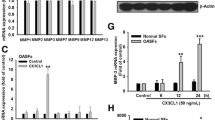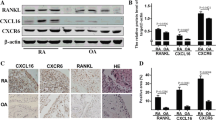Abstract
Joint destruction and excessive bone formation are associated with high expression of soluble receptor activator of nuclear factor-κB ligand (sRANKL). This study was undertaken to investigate the role of sRANKL in collagenase-induced osteoarthritis (CIOA) in mice and in patients with osteoarthritis (OA). The initial phase of CIOA was associated with severe proteoglycan depletion, decreased collagen density, and up-regulation of bone morphogenetic protein (BMP)-2. At the late stage of CIOA, bone remodeling was related with increased BMP2 and RANKL expression in the joints, high sRANKL, and decreased number of activated neutrophils in synovium. CIOA mice showed elevated plasma level of sRANKL but low RANKL expression on blood neutrophils. The percentage of RANKL-positive blood neutrophils was higher in patients with OA than in healthy individuals. Our data indicate that increased local and systemic levels of soluble RANKL might be indicative for OA disorders in mouse and human.






Similar content being viewed by others
References
Brandt KD (2003) Osteoarthritis. Preface. Rheum Dis Clin North Am 29:ix–xiii. doi:10.1016/S0889-857X(03)00076-0
Yasuda H, Shima N, Nakagawa N, Yamaguchi K et al (1998) Osteoclast differentiation factor is a ligand for osteoprotegerin/osteoclastogenesis-inhibitory factor and is identical to TRANCE/RANKL. Proc Natl Acad Sci USA 95:3597–3602. doi:10.1073/pnas.202332999
Teitelbaum SL (2000) Bone resorption by osteoclasts. Science 289:1504–1508. doi:10.1126/science.289.5484.1504
Li J, Sarosi I, Yan XQ et al (2000) RANK is the intrinsic hematopoietic cell surface receptor that controls osteoclastogenesis and regulation of bone mass and calcium metabolism. Proc Natl Acad Sci USA 97:1566–1571
Naito A, Azuma S, Tanaka S et al (1999) Severe osteopetrosis, defective interleukin-1 signalling and lymph node organogenesis in TRAF6-deficient mice. Genes Cells 4:353–362. doi:10.1046/j.1365-2443.1999.00265.x
Franzoso G, Carlson L, Xing L et al (1997) Requirement for NF-kappaB in osteoclast and B-cell development. Genes Dev 11:3482–3496. doi:10.1101/gad.11.24.3482
Hofbauer LC, Dunstan CR, Spelsberg TC, Riggs BL, Khosla S (1998) Osteoprotegerin production by human osteoblast lineage cells is stimulated by vitamin D, bone morphogenetic protein-2, and cytokines. Biochem Biophys Res Commun 250:776–781. doi:10.1006/bbrc.1998.9394
Nakashima T, Kobayashi Y, Yamasaki S, Kawakami A, Eguchi K, Sasaki H, Sakai H (2000) Protein expression and functional difference of membrane-bound and soluble receptor activator of NF-kappaB ligand: modulation of the expression by osteotropic factors and cytokines. Biochem Biophys Res Commun 275:768–775. doi:10.1006/bbrc.2000.3379
Crotti TN, Smith MD, Weedon H, Ahern MJ, Findlay DM, Kraan M, Tak PP, Haynes DR (2002) Receptor activator NF-kappaB ligand (RANKL) expression in synovial tissue from patients with rheumatoid arthritis, spondyloarthropathy, osteoarthritis, and from normal patients: semiquantitative and quantitative analysis. Ann Rheum Dis 61:1047–1054. doi:10.1136/ard.61.12.1047
Gravallese EM, Manning C, Tsay A, Naito A, Pan C, Amento E, Goldring SR (2000) Synovial tissue in rheumatoid arthritis is a source of osteoclast differentiation factor. Arthritis Rheum 43:250–258. doi:10.1002/1529-0131(200002)43:2<250:AID-ANR3>3.0.CO;2-P
Ji H, Pettit A, Ohmura K et al (2002) Critical roles for interleukin 1 and tumor necrosis factor alpha in antibody-induced arthritis. J Exp Med 196:77–85. doi:10.1084/jem.20020439
Keffer J, Probert L, Cazlaris H, Georgopoulos S, Kaslaris E, Kioussis D, Kollias G (1991) Transgenic mice expressing human tumour necrosis factor: a predictive genetic model of arthritis. EMBO J 10:4025–4031
Kamijo S, Nakajima A, Ikeda K, Aoki K, Ohya K, Akiba H, Yagita H, Okumura K (2006) Amelioration of bone loss in collagen-induced arthritis by neutralizing anti-RANKL monoclonal antibody. Biochem Biophys Res Commun 347:124–132. doi:10.1016/j.bbrc.2006.06.098
Bekker PJ, Holloway DL, Rasmussen AS et al (2004) A single-dose placebo-controlled study of AMG 162, a fully human monoclonal antibody to RANKL, in postmenopausal women. J Bone Miner Res 19:1059–1066. doi:10.1359/JBMR.040305
Santos LL, Morand EF, Hutchinson P, Boyce NW, Holdsworth SR (1997) Anti-neutrophil monoclonal antibody therapy inhibits the development of adjuvant arthritis. Clin Exp Immunol 107:248–253. doi:10.1111/j.1365-2249.1997.263-ce1154.x
Chakrabarti S, Patel KD (2005) Regulation of matrix metalloproteinase-9 release from IL-8-stimulated human neutrophils. J Leukoc Biol 78:279–288. doi:10.1189/jlb.1004612
Felzmann T, Gadd S, Majdic O, Maurer D, Petera P, Smolen J, Knapp W (1991) Analysis of function-associated receptor molecules on peripheral blood and synovial fluid granulocytes from patients with rheumatoid and reactive arthritis. J Clin Immunol 11:205–212
Pronai L, Ichikawa Y, Ichimori K, Nakazawa H, Arimori S (1991) Association of enhanced superoxide generation by neutrophils with low superoxide scavenging activity of the peripheral blood, joint fluid, and their leukocyte components in rheumatoid arthritis: effects of slow-acting anti-rheumatic drugs and disease activity. Clin Exp Rheumatol 9:149–155
Kragstrup TW, Otkjaer K, Holm C, Jorgensen A, Hokland M, Iversen L, Deleuran B (2008) The expression of IL-20 and IL-24 and their shared receptors are increased in rheumatoid arthritis and spondyloarthropathy. Cytokine 41:16–23. doi:10.1016/j.cyto.2007.10.004
Shen F, Ruddy MJ, Plamondon P, Gaffen SL (2005) Cytokines link osteoblasts and inflammation: microarray analysis of interleukin-17- and TNF-alpha-induced genes in bone cells. J Leukoc Biol 77:388–399. doi:10.1189/jlb.0904490
Poubelle PE, Chakravarti A, Fernandes MJ, Doiron K, Marceau AA (2007) Differential expression of RANK, RANK-L, and osteoprotegerin by synovial fluid neutrophils from patients with rheumatoid arthritis and by healthy human blood neutrophils. Arthritis Res Ther 9:R25. doi:10.1186/ar2137
Pritzker KP, Gay S, Jimenez SA, Ostergaard K, Pelletier JP, Revell PA, Salter D, van den Berg WB (2006) Osteoarthritis cartilage histopathology: grading and staging. Osteoarthritis Cartilage 14:13–29. doi:10.1016/j.joca.2005.07.014
Simonet WS, Lacey DL, Dunstan CR et al (1997) Osteoprotegerin: a novel secreted protein involved in the regulation of bone density. Cell 89:309–319
Daans M, Lories RJ, Luyten FP (2008) Dynamic activation of bone morphogenetic protein signaling in collagen-induced arthritis supports their role in joint homeostasis and disease. Arthritis Res Ther 10:R115. doi:10.1186/ar2518
Ikeda T, Kasai M, Utsuyama M, Hirokawa K (2001) Determination of three isoforms of the receptor activator of nuclear factor-kappaB ligand and their differential expression in bone and thymus. Endocrinology 142:1419–1426
Gonzalez-Alvaro I, Ortiz AM, Tomero EG, Balsa A, Orte J, Laffon A, Garcia-Vicuna R (2007) Baseline serum RANKL levels may serve to predict remission in rheumatoid arthritis patients treated with TNF antagonists. Ann Rheum Dis 66:1675–1678. doi:10.1136/ard.2007.071910
Pilichou A, Papassotiriou I, Michalakakou K, Fessatou S, Fandridis E, Papachristou G, Terpos E (2008) High levels of synovial fluid osteoprotegerin (OPG) and increased serum ratio of receptor activator of nuclear factor-kappa B ligand (RANKL) to OPG correlate with disease severity in patients with primary knee osteoarthritis. Clin Biochem 41:746–749. doi:10.1016/j.clinbiochem.2008.02.011
Toncheva A, Remichkova M, Ikonomova K, Dimitrova P, Ivanovska N (2009) Inflammatory response in patients with active and inactive osteoarthritis. Rheumatol Int 29:1197–1203. doi:10.1007/s00296-009-0864-0
Acknowledgments
This work was supported by Grants KT-X-1707 and BG051PO001-3.3.04/32 from the National Science Fund, Ministry of Education and Science, Bulgaria.
Conflict of interests
Authors declare that they have no conflict of interests.
Author information
Authors and Affiliations
Corresponding author
Rights and permissions
About this article
Cite this article
Dimitrova, P., Toncheva, A., Gyurkovska, V. et al. Involvement of soluble receptor activator of nuclear factor-κB ligand (sRANKL) in collagenase-induced murine osteoarthritis and human osteoarthritis. Rheumatol Int 32, 1317–1325 (2012). https://doi.org/10.1007/s00296-010-1723-8
Received:
Accepted:
Published:
Issue Date:
DOI: https://doi.org/10.1007/s00296-010-1723-8




